Descriptor/
Button |
Supported Spectral Types |
Explanation |
ABL
 |
IR, UV/VIS/NIR, THz, Raman, X-Ray Diff. |
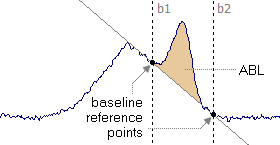 Area: sum of intensities between two reference points with the baseline subtracted. The user has to specify the two reference points b1 and b2 to calculate the baseline. In order to avoid a baseline too sensitive to noise the parameter "Nb" defines the number of surrounding data points to obtain the baseline reference points. Area: sum of intensities between two reference points with the baseline subtracted. The user has to specify the two reference points b1 and b2 to calculate the baseline. In order to avoid a baseline too sensitive to noise the parameter "Nb" defines the number of surrounding data points to obtain the baseline reference points. |
| |
ALV
 |
IR, UV/VIS/NIR, THz, Raman, X-Ray Diff. |
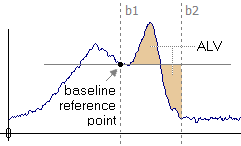 Area: sum of all intensities between two reference points; the baseline is defined by the level of the reference point b1. In order to minimize the influence of noise in the data, the parameter "Nb" defines the number of surrounding data points used to obtain the baseline reference point. Please note that areas below the reference level are subtracted. Area: sum of all intensities between two reference points; the baseline is defined by the level of the reference point b1. In order to minimize the influence of noise in the data, the parameter "Nb" defines the number of surrounding data points used to obtain the baseline reference point. Please note that areas below the reference level are subtracted. |
| |
ARW
 |
All |
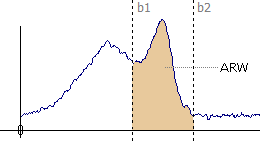 Area: the sum of intensities between two reference points; no baseline is subtracted. Area: the sum of intensities between two reference points; no baseline is subtracted. |
| |
BBL
 |
All |
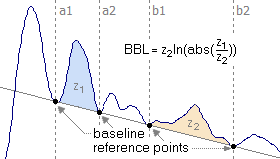 The logarithm of the ratio of two peak areas (with the baseline subtracted) weighted by the area of the second peak. The baseline is calculated separately for each of the two areas. In order to minimize the influence of noise in the data, the parameter "Nb" defines the number of surrounding data points used to obtain the baseline reference point. The logarithm of the ratio of two peak areas (with the baseline subtracted) weighted by the area of the second peak. The baseline is calculated separately for each of the two areas. In order to minimize the influence of noise in the data, the parameter "Nb" defines the number of surrounding data points used to obtain the baseline reference point. |
| |
BRW
 |
All |
 The logarithm of the ratio of two peak areas weighted by the area of the second peak; no baseline is subtracted. The logarithm of the ratio of two peak areas weighted by the area of the second peak; no baseline is subtracted. |
| |
CEN
 |
IR, UV/VIS/NIR, THz, Raman, X-Ray Diff. |
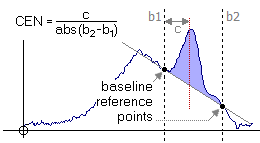 Centroid: the position of the centroid of the baseline-subtracted spectral line within the boundaries b1 and b2. The value of CEN may assume values between 0 and 1. Centroid: the position of the centroid of the baseline-subtracted spectral line within the boundaries b1 and b2. The value of CEN may assume values between 0 and 1.
|
| |
COO
 |
IR, UV/VIS/NIR, THz, Raman, X-Ray Diff. |
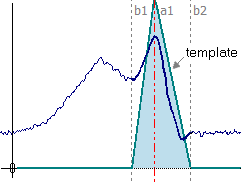 Correlation with a positive triangle template peak. The height of the triangular template peak is always 1.0, its shape is controlled by the points [b1,0], [a1,1], and [b2,0]. Please note that in contrast to the TC descriptor this descriptor simply returns the correlation (no weighting, no significance test). Correlation with a positive triangle template peak. The height of the triangular template peak is always 1.0, its shape is controlled by the points [b1,0], [a1,1], and [b2,0]. Please note that in contrast to the TC descriptor this descriptor simply returns the correlation (no weighting, no significance test). |
| |
DV1
 |
IR, UV/VIS/NIR, THz, Raman, X-Ray Diff. |
 First Derivative: the smoothed first derivative of the spectral curve at a particular position (a1). The smoothing of the first derivative can be controlled by the number of data points used for the polynomial smoothing function and is determined by the parameter halfwidth (number of smoothing points = 2*halfwidth+1). First Derivative: the smoothed first derivative of the spectral curve at a particular position (a1). The smoothing of the first derivative can be controlled by the number of data points used for the polynomial smoothing function and is determined by the parameter halfwidth (number of smoothing points = 2*halfwidth+1).
Please note that the first derivative degrades towards zero at both ends of the spectrum. For reliable use of the DV1 descriptor the position a1 should be in the interval [HW,L-HW], with HW being the halfwidth and L being the length of the spectrum (= number of layers of the corresponding spectral group).
|
| |
GC
 |
IR, UV/VIS/NIR, THz, Raman, X-Ray Diff. |
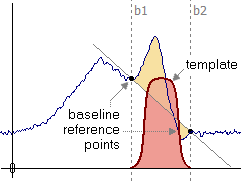 Significant positive correlation (level of significance = 0.01) with a general Gaussian template peak, multiplied by the signal area. Please note that this descriptor is set to zero if the correlation is either negative or not significant. The signal area is calculated by subtracting the area below the baseline from the integral between the reference points b1 and b2. The height of the template peak is always 1.0, its shape is controlled by the points [b1,0] and [b2,0] and the parameter "flatness". A flatness value of 1 correponds to a Gaussian bell curve, higher values flatten the top of the curve. Significant positive correlation (level of significance = 0.01) with a general Gaussian template peak, multiplied by the signal area. Please note that this descriptor is set to zero if the correlation is either negative or not significant. The signal area is calculated by subtracting the area below the baseline from the integral between the reference points b1 and b2. The height of the template peak is always 1.0, its shape is controlled by the points [b1,0] and [b2,0] and the parameter "flatness". A flatness value of 1 correponds to a Gaussian bell curve, higher values flatten the top of the curve.
|
| |
GCI
 |
IR, UV/VIS/NIR, THz, Raman, X-Ray Diff. |
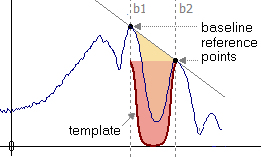 Significant positive correlation (level of significance = 0.01) with a general inverse Gaussian template peak, multiplied by the signal area. Please note that this descriptor is set to zero if the correlation is either negative or not significant. The signal area is calculated by subtracting the area above the baseline from the integral between the reference points b1 and b2. The height of the template peak is always 1.0, its shape is controlled by the points [b1,0] and [b2,0] and the parameter "flatness". A flatness value of 1 correponds to a Gaussian bell curve, higher values flatten the top of the curve. Significant positive correlation (level of significance = 0.01) with a general inverse Gaussian template peak, multiplied by the signal area. Please note that this descriptor is set to zero if the correlation is either negative or not significant. The signal area is calculated by subtracting the area above the baseline from the integral between the reference points b1 and b2. The height of the template peak is always 1.0, its shape is controlled by the points [b1,0] and [b2,0] and the parameter "flatness". A flatness value of 1 correponds to a Gaussian bell curve, higher values flatten the top of the curve.
|
| |
LAR
 |
All |
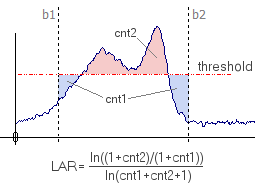 This descriptor counts the values above and below a threshold within the interval [b1,b2] and calculates the logarithm of the ratio of the two counts: LAR = ln((1+cnt1)/(1+cnt2))/ln(cnt1+cnt2+1). The range of the LAR descriptor is limited to the interval [-1.0, 1.0]. This descriptor counts the values above and below a threshold within the interval [b1,b2] and calculates the logarithm of the ratio of the two counts: LAR = ln((1+cnt1)/(1+cnt2))/ln(cnt1+cnt2+1). The range of the LAR descriptor is limited to the interval [-1.0, 1.0].
|
| |
PBL
 |
IR, UV/VIS/NIR, THz, Raman, X-Ray Diff. |
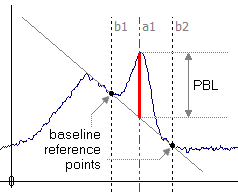 Peak: single intensity at a particular wavelength or mass; the baseline is subtracted. The user has to specify the two reference points b1 and b2 which are used to calculate the baseline. In order to avoid a baseline too sensitive to noise in the data, the parameter "Nb" defines the number of surrounding data points used to obtain the baseline reference points. Peak: single intensity at a particular wavelength or mass; the baseline is subtracted. The user has to specify the two reference points b1 and b2 which are used to calculate the baseline. In order to avoid a baseline too sensitive to noise in the data, the parameter "Nb" defines the number of surrounding data points used to obtain the baseline reference points. |
| |
PLV
 |
IR, UV/VIS/NIR, THz, Raman, X-Ray Diff. |
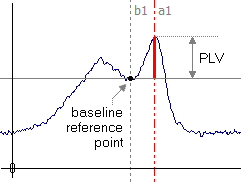 Peak: single intensity at a particular wavelength or mass; the baseline is defined by the level of a single reference point b1. In order to minimize the influence of noise the parameter "Nb" defines the number of surrounding data points used to obtain the baseline reference point. Peak: single intensity at a particular wavelength or mass; the baseline is defined by the level of a single reference point b1. In order to minimize the influence of noise the parameter "Nb" defines the number of surrounding data points used to obtain the baseline reference point. |
| |
PRW
 |
All |
 Raw peak: single unprocessed intensity at a particular wavelength or mass; the baseline is not subtracted. This kind of descriptor is most suitable for baseline corrected spectra. Raw peak: single unprocessed intensity at a particular wavelength or mass; the baseline is not subtracted. This kind of descriptor is most suitable for baseline corrected spectra. |
| |
RBL
 |
IR, UV/VIS/NIR, THz, Raman, X-Ray Diff. |
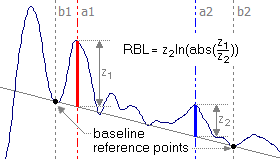 Peak ratio: the logarithm of the ratio of two peak intensities at two different wavelengths weighted by the intensity of the second peak. The peak intensities are measured relative to a baseline which is obtained from two reference points. Please note that values of RBL are restricted to a minium or maximum value which can be set in the Preferences dialog. By default the RBL values are restricted to +/- 4.6052 (which is equivalent to a dynamic range of 1:100). Peak ratio: the logarithm of the ratio of two peak intensities at two different wavelengths weighted by the intensity of the second peak. The peak intensities are measured relative to a baseline which is obtained from two reference points. Please note that values of RBL are restricted to a minium or maximum value which can be set in the Preferences dialog. By default the RBL values are restricted to +/- 4.6052 (which is equivalent to a dynamic range of 1:100).
|
| |
RLV
 |
IR, UV/VIS/NIR, THz, Raman, X-Ray Diff. |
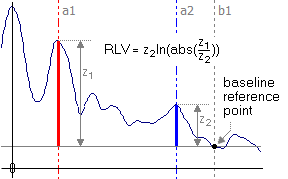 Peak ratio: the logarithm of the ratio of two peak intensities at two different wavelengths weighted by the intensity of the second peak. The peak intensities are measured relative to a horizontal baseline which is defined by a reference point (intersection of the cursor b1 and the signal). Please note that values of RLV are restricted to a minium or maximum value which can be set in the Preferences dialog. By default the RLV values are restricted to +/- 4.6052 (which is equivalent to a dynamic range of 1:100). Peak ratio: the logarithm of the ratio of two peak intensities at two different wavelengths weighted by the intensity of the second peak. The peak intensities are measured relative to a horizontal baseline which is defined by a reference point (intersection of the cursor b1 and the signal). Please note that values of RLV are restricted to a minium or maximum value which can be set in the Preferences dialog. By default the RLV values are restricted to +/- 4.6052 (which is equivalent to a dynamic range of 1:100).
|
| |
RRW
 |
All |
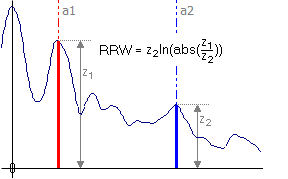 Raw peak ratio: the logarithm of the ratio of two peak intensities at two different wavelengths weighted by the intensity of the second peak. Please note that values of RRW are restricted to a minium or maximum value which can be set in the Preferences dialog. By default the RRW values are restricted to +/- 4.6052 (which is equivalent to a dynamic range of 1:100). Raw peak ratio: the logarithm of the ratio of two peak intensities at two different wavelengths weighted by the intensity of the second peak. Please note that values of RRW are restricted to a minium or maximum value which can be set in the Preferences dialog. By default the RRW values are restricted to +/- 4.6052 (which is equivalent to a dynamic range of 1:100).
|
| |
TC
 |
IR, UV/VIS/NIR, THz, Raman, X-Ray Diff. |
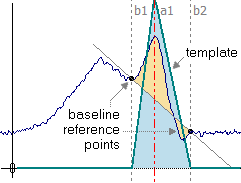 Significant positive correlation (level of significance = 0.01) with a positive triangle template peak, multiplied by the signal area. Please note that this descriptor is set to zero if the correlation is either negative or not significant. The signal area is calculated by subtracting the area below the baseline from the integral between the reference points b1 and b2. The height of the triangular template peak is always 1.0, its shape is controlled by the points [b1,0], [a1,1], and [b2,0]. Significant positive correlation (level of significance = 0.01) with a positive triangle template peak, multiplied by the signal area. Please note that this descriptor is set to zero if the correlation is either negative or not significant. The signal area is calculated by subtracting the area below the baseline from the integral between the reference points b1 and b2. The height of the triangular template peak is always 1.0, its shape is controlled by the points [b1,0], [a1,1], and [b2,0]. |
| |
TCI
 |
IR, UV/VIS/NIR, THz, Raman, X-Ray Diff. |
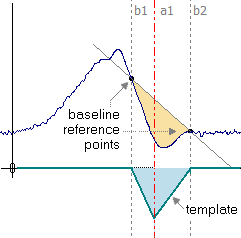 Significant positive correlation (level of significance = 0.01) with an negative triangle template peak, multiplied by the signal area. Please note that this descriptor is set to zero if the correlation is either negative or not significant. The signal area is calculated by subtracting the area below the baseline from the integral between the reference points b1 and b2. The height of the triangular template peak is always -1.0, its shape is controlled by the points [b1,0], [a1,1], and [b2,0]. Significant positive correlation (level of significance = 0.01) with an negative triangle template peak, multiplied by the signal area. Please note that this descriptor is set to zero if the correlation is either negative or not significant. The signal area is calculated by subtracting the area below the baseline from the integral between the reference points b1 and b2. The height of the triangular template peak is always -1.0, its shape is controlled by the points [b1,0], [a1,1], and [b2,0]. |
| |
VAR
 |
IR, UV/VIS/NIR, THz, Raman, X-Ray Diff. |
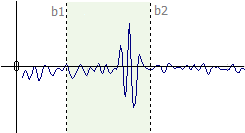 Variance of the first derivative of the spectral line within the boundaries b1 and b2. The value of VAR is normalized to the total variance of the spectrum and may assume values between 0 and approx. 1, in certain rare cases the value can become 2 or higher. Variance of the first derivative of the spectral line within the boundaries b1 and b2. The value of VAR is normalized to the total variance of the spectrum and may assume values between 0 and approx. 1, in certain rare cases the value can become 2 or higher.
|

 Spectral Descriptors
Spectral Descriptors  Spectral Descriptors
Spectral Descriptors



 Area: sum of intensities between two reference points with the baseline subtracted. The user has to specify the two reference points b1 and b2 to calculate the baseline. In order to avoid a baseline too sensitive to noise the parameter "Nb" defines the number of surrounding data points to obtain the baseline reference points.
Area: sum of intensities between two reference points with the baseline subtracted. The user has to specify the two reference points b1 and b2 to calculate the baseline. In order to avoid a baseline too sensitive to noise the parameter "Nb" defines the number of surrounding data points to obtain the baseline reference points.
 Area: sum of all intensities between two reference points; the baseline is defined by the level of the reference point b1. In order to minimize the influence of noise in the data, the parameter "Nb" defines the number of surrounding data points used to obtain the baseline reference point. Please note that areas below the reference level are subtracted.
Area: sum of all intensities between two reference points; the baseline is defined by the level of the reference point b1. In order to minimize the influence of noise in the data, the parameter "Nb" defines the number of surrounding data points used to obtain the baseline reference point. Please note that areas below the reference level are subtracted.
 Area: the sum of intensities between two reference points; no baseline is subtracted.
Area: the sum of intensities between two reference points; no baseline is subtracted.
 The logarithm of the ratio of two peak areas (with the baseline subtracted) weighted by the area of the second peak. The baseline is calculated separately for each of the two areas. In order to minimize the influence of noise in the data, the parameter "Nb" defines the number of surrounding data points used to obtain the baseline reference point.
The logarithm of the ratio of two peak areas (with the baseline subtracted) weighted by the area of the second peak. The baseline is calculated separately for each of the two areas. In order to minimize the influence of noise in the data, the parameter "Nb" defines the number of surrounding data points used to obtain the baseline reference point.
 The logarithm of the ratio of two peak areas weighted by the area of the second peak; no baseline is subtracted.
The logarithm of the ratio of two peak areas weighted by the area of the second peak; no baseline is subtracted.
 Centroid: the position of the centroid of the baseline-subtracted spectral line within the boundaries b1 and b2. The value of CEN may assume values between 0 and 1.
Centroid: the position of the centroid of the baseline-subtracted spectral line within the boundaries b1 and b2. The value of CEN may assume values between 0 and 1.

 Correlation with a positive triangle template peak. The height of the triangular template peak is always 1.0, its shape is controlled by the points [b1,0], [a1,1], and [b2,0]. Please note that in contrast to the TC descriptor this descriptor simply returns the correlation (no weighting, no significance test).
Correlation with a positive triangle template peak. The height of the triangular template peak is always 1.0, its shape is controlled by the points [b1,0], [a1,1], and [b2,0]. Please note that in contrast to the TC descriptor this descriptor simply returns the correlation (no weighting, no significance test).
 First Derivative: the smoothed first derivative of the spectral curve at a particular position (a1). The smoothing of the first derivative can be controlled by the number of data points used for the polynomial smoothing function and is determined by the parameter halfwidth (number of smoothing points = 2*halfwidth+1).
First Derivative: the smoothed first derivative of the spectral curve at a particular position (a1). The smoothing of the first derivative can be controlled by the number of data points used for the polynomial smoothing function and is determined by the parameter halfwidth (number of smoothing points = 2*halfwidth+1).

 Significant positive correlation (level of significance = 0.01) with a general Gaussian template peak, multiplied by the signal area. Please note that this descriptor is set to zero if the correlation is either negative or not significant. The signal area is calculated by subtracting the area below the baseline from the integral between the reference points b1 and b2. The height of the template peak is always 1.0, its shape is controlled by the points [b1,0] and [b2,0] and the parameter "flatness". A flatness value of 1 correponds to a Gaussian bell curve, higher values flatten the top of the curve.
Significant positive correlation (level of significance = 0.01) with a general Gaussian template peak, multiplied by the signal area. Please note that this descriptor is set to zero if the correlation is either negative or not significant. The signal area is calculated by subtracting the area below the baseline from the integral between the reference points b1 and b2. The height of the template peak is always 1.0, its shape is controlled by the points [b1,0] and [b2,0] and the parameter "flatness". A flatness value of 1 correponds to a Gaussian bell curve, higher values flatten the top of the curve.

 Significant positive correlation (level of significance = 0.01) with a general inverse Gaussian template peak, multiplied by the signal area. Please note that this descriptor is set to zero if the correlation is either negative or not significant. The signal area is calculated by subtracting the area above the baseline from the integral between the reference points b1 and b2. The height of the template peak is always 1.0, its shape is controlled by the points [b1,0] and [b2,0] and the parameter "flatness". A flatness value of 1 correponds to a Gaussian bell curve, higher values flatten the top of the curve.
Significant positive correlation (level of significance = 0.01) with a general inverse Gaussian template peak, multiplied by the signal area. Please note that this descriptor is set to zero if the correlation is either negative or not significant. The signal area is calculated by subtracting the area above the baseline from the integral between the reference points b1 and b2. The height of the template peak is always 1.0, its shape is controlled by the points [b1,0] and [b2,0] and the parameter "flatness". A flatness value of 1 correponds to a Gaussian bell curve, higher values flatten the top of the curve.

 This descriptor counts the values above and below a threshold within the interval [b1,b2] and calculates the logarithm of the ratio of the two counts: LAR = ln((1+cnt1)/(1+cnt2))/ln(cnt1+cnt2+1). The range of the LAR descriptor is limited to the interval [-1.0, 1.0].
This descriptor counts the values above and below a threshold within the interval [b1,b2] and calculates the logarithm of the ratio of the two counts: LAR = ln((1+cnt1)/(1+cnt2))/ln(cnt1+cnt2+1). The range of the LAR descriptor is limited to the interval [-1.0, 1.0].

 Peak: single intensity at a particular wavelength or mass; the baseline is subtracted. The user has to specify the two reference points b1 and b2 which are used to calculate the baseline. In order to avoid a baseline too sensitive to noise in the data, the parameter "Nb" defines the number of surrounding data points used to obtain the baseline reference points.
Peak: single intensity at a particular wavelength or mass; the baseline is subtracted. The user has to specify the two reference points b1 and b2 which are used to calculate the baseline. In order to avoid a baseline too sensitive to noise in the data, the parameter "Nb" defines the number of surrounding data points used to obtain the baseline reference points.
 Peak: single intensity at a particular wavelength or mass; the baseline is defined by the level of a single reference point b1. In order to minimize the influence of noise the parameter "Nb" defines the number of surrounding data points used to obtain the baseline reference point.
Peak: single intensity at a particular wavelength or mass; the baseline is defined by the level of a single reference point b1. In order to minimize the influence of noise the parameter "Nb" defines the number of surrounding data points used to obtain the baseline reference point.
 Raw peak: single unprocessed intensity at a particular wavelength or mass; the baseline is not subtracted. This kind of descriptor is most suitable for baseline corrected spectra.
Raw peak: single unprocessed intensity at a particular wavelength or mass; the baseline is not subtracted. This kind of descriptor is most suitable for baseline corrected spectra.
 Peak ratio: the logarithm of the ratio of two peak intensities at two different wavelengths weighted by the intensity of the second peak. The peak intensities are measured relative to a baseline which is obtained from two reference points. Please note that values of RBL are restricted to a minium or maximum value which can be set in the
Peak ratio: the logarithm of the ratio of two peak intensities at two different wavelengths weighted by the intensity of the second peak. The peak intensities are measured relative to a baseline which is obtained from two reference points. Please note that values of RBL are restricted to a minium or maximum value which can be set in the 
 Peak ratio: the logarithm of the ratio of two peak intensities at two different wavelengths weighted by the intensity of the second peak. The peak intensities are measured relative to a horizontal baseline which is defined by a reference point (intersection of the cursor b1 and the signal). Please note that values of RLV are restricted to a minium or maximum value which can be set in the
Peak ratio: the logarithm of the ratio of two peak intensities at two different wavelengths weighted by the intensity of the second peak. The peak intensities are measured relative to a horizontal baseline which is defined by a reference point (intersection of the cursor b1 and the signal). Please note that values of RLV are restricted to a minium or maximum value which can be set in the 
 Raw peak ratio: the logarithm of the ratio of two peak intensities at two different wavelengths weighted by the intensity of the second peak. Please note that values of RRW are restricted to a minium or maximum value which can be set in the
Raw peak ratio: the logarithm of the ratio of two peak intensities at two different wavelengths weighted by the intensity of the second peak. Please note that values of RRW are restricted to a minium or maximum value which can be set in the 
 Significant positive correlation (level of significance = 0.01) with a positive triangle template peak, multiplied by the signal area. Please note that this descriptor is set to zero if the correlation is either negative or not significant. The signal area is calculated by subtracting the area below the baseline from the integral between the reference points b1 and b2. The height of the triangular template peak is always 1.0, its shape is controlled by the points [b1,0], [a1,1], and [b2,0].
Significant positive correlation (level of significance = 0.01) with a positive triangle template peak, multiplied by the signal area. Please note that this descriptor is set to zero if the correlation is either negative or not significant. The signal area is calculated by subtracting the area below the baseline from the integral between the reference points b1 and b2. The height of the triangular template peak is always 1.0, its shape is controlled by the points [b1,0], [a1,1], and [b2,0].
 Significant positive correlation (level of significance = 0.01) with an negative triangle template peak, multiplied by the signal area. Please note that this descriptor is set to zero if the correlation is either negative or not significant. The signal area is calculated by subtracting the area below the baseline from the integral between the reference points b1 and b2. The height of the triangular template peak is always -1.0, its shape is controlled by the points [b1,0], [a1,1], and [b2,0].
Significant positive correlation (level of significance = 0.01) with an negative triangle template peak, multiplied by the signal area. Please note that this descriptor is set to zero if the correlation is either negative or not significant. The signal area is calculated by subtracting the area below the baseline from the integral between the reference points b1 and b2. The height of the triangular template peak is always -1.0, its shape is controlled by the points [b1,0], [a1,1], and [b2,0].
 Variance of the first derivative of the spectral line within the boundaries b1 and b2. The value of VAR is normalized to the total variance of the spectrum and may assume values between 0 and approx. 1, in certain rare cases the value can become 2 or higher.
Variance of the first derivative of the spectral line within the boundaries b1 and b2. The value of VAR is normalized to the total variance of the spectrum and may assume values between 0 and approx. 1, in certain rare cases the value can become 2 or higher.
